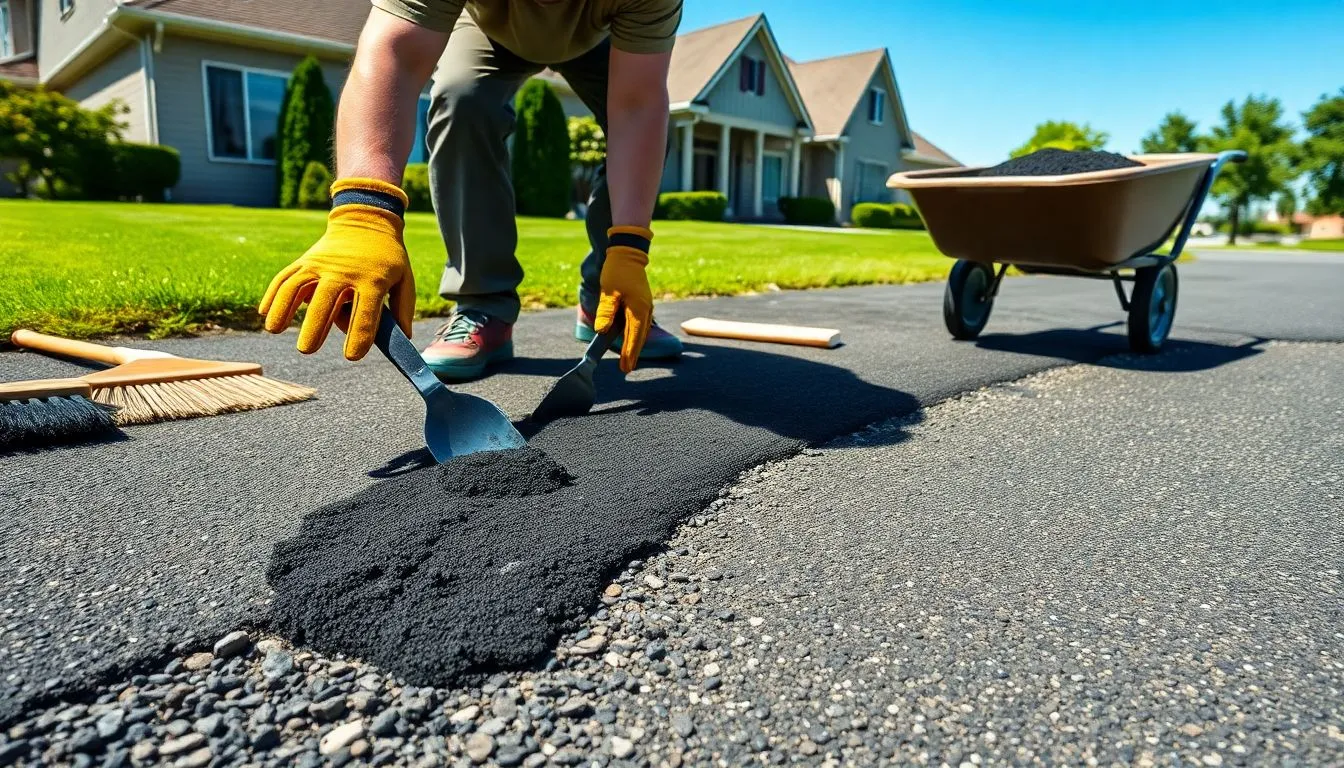Introduction
DIY Asphalt Patching Step-by-Step is the smartest way to tackle a cracked or pothole-riddled driveway that can hurt your curb appeal and even become a safety hazard. Acting quickly to patch damaged asphalt keeps small problems from turning into costly repairs.
Weather, heavy traffic, and old age are the main enemies of your driveway’s smooth surface. Luckily, patching your asphalt yourself can save money and time, all while preserving your home’s look. This guide offers a clear, step-by-step process to repair your driveway using simple tools and basic skills. You can do this without hiring an expert!
Recognizing Asphalt Damage and Knowing When to Do It Yourself
Recognizing Common Types of Asphalt Damage
Asphalt can crack, develop potholes, or begin to crumble with time. Cracks are often small but can grow if ignored. Larger holes known as potholes develop as water seeps in and erodes the pavement. Surface raveling happens when the top layer wears away, leaving a rough patch. Knowing these signs helps you decide if you need a quick patch or a full resurfacing. Small cracks can usually be patched DIY style, but large, deep potholes might need professional help.
When to Patch Yourself vs. When to Call Professionals
The rule of thumb? Keep patches for damage under a foot wide and not too deep. If you see damage over that size or with a lot of damage underneath, call in the pros. Safety is key: If the damage involves deep holes or unstable ground, it’s better to leave it to experts. Also, think about your skill level and tools. Patching small areas saves money and time, but major fixes are best left to pros who have the right equipment. Overall, DIY patching makes sense for minor repairs, not extensive damage.
Preparing for Asphalt Patching
Gathering Necessary Tools and Materials
Start with the basics: asphalt patch (cold mix or hot mix), a sturdy shovel, tamper or plate compactor, safety gear (gloves, goggles), and a broom. Cold patch asphalt may be used in various weather situations and is simpler to deal with, especially for novices. Hot mix gives a stronger repair but needs special handling and equipment. You’ll also want water, a hose, and a paint squeegee if needed. Having all the tools ready saves time and makes the job easier.
Assessing and Cleaning the Damaged Area
Inspect your repair zone closely. Remove loose asphalt, dirt, mud, or plants from the damaged spot. Use a broom or brush to clear debris. If oil or grease is present, clean it with water and soap. Be sure the area is dry; moisture can cause patches to fail. The more thoroughly you clean, the better the patch will stick and last.
Preparing the Base Surface
Deep potholes need filling before patching. Fill these with gravel or crushed stone and compact it tightly. A good base prevents future sinking or cracking. Raking flat and ensuring no loose pieces remain helps create a solid foundation. Without a stable base, patches may fall apart or settle unevenly over time.
Step-by-Step Asphalt Patching Process
Applying Cold Patch or Hot Mix Asphalt
For small repairs, cold patch asphalt is convenient. Spread the patch material over the damaged area, filling it slightly above the surrounding surface. Make sure your hot mix asphalt is heated and ready to use. Be cautious with hot asphalt to avoid burns and mishandling.
Filling and Leveling the Damage
Fill the hole with your patch material, overfilling slightly to prevent low spots after settling. Use a shovel or rake to spread it evenly, making sure it’s flush with the driveway surface. A flat, smooth patch looks better and prevents tripping hazards.
Compacting and Finishing the Patch
Press the patch down using a plate compactor or tamper. Tamping tightly ensures it won’t sink or crack easily. Check if the patch is level with the surrounding pavement, then smooth it out. Let the patch cure or set as per product instructions — this can take a few hours or overnight, depending on the material.
Tips for Long-Term Maintenance and Prevention
Sealcoating for Enhanced Durability
Sealcoating creates a barrier against water, oils, and UV rays. It helps protect and prolong your patch work. Reapply sealcoating every 2-3 years for best results, especially in harsh climates.
Regular Inspection and Maintenance
Make it a habit to check your driveway every few months. Small cracks or holes can be fixed before they worsen. Quickly fixing minor issues saves money in the long run. Prompt repairs stop water from seeping in and damaging the base.
Additional Repair Tips from Industry Experts
Avoid using too much patch material — it can cause uneven surfaces. Always clean the area thoroughly before applying new asphalt. Don’t patch in extreme weather; extreme cold or heat can affect adhesion. Finally, remember that patience and careful work make a big difference in the longevity of your patch.
Conclusion
Proper preparation and careful execution make DIY asphalt patching manageable and effective. Fixing small damages promptly can extend your driveway’s life and save money. Regular maintenance — like sealing and inspections — keeps your driveway in top shape. The key is to stay proactive and fix issues early. Schedule routine checks and patch those little cracks before they become big problems. Maintain the brand-new appearance and functionality of your driveway for many years to come.
Found this guide helpful? Share it or check out our Asphalt Cost Calculator to plan your next repair!
❓ FAQs (with SEO-Optimized Answers)
1. Can I patch asphalt myself, or should I hire a professional?
Yes, you can patch asphalt yourself if the damage is minor (e.g., shallow cracks or small potholes). DIY asphalt patching is cost-effective and ideal for light repairs. For deep potholes or widespread damage, hiring a professional ensures a longer-lasting fix.
2. What’s the best asphalt patch for DIY driveway repair?
Cold mix asphalt is the best option for DIY repairs. It’s easy to use, doesn’t require heating, and works well for patching small cracks and potholes in various weather conditions.
3. How long does it take for the asphalt patch to cure?
Cold patch asphalt usually cures in 24 to 48 hours, but this can vary depending on weather and thickness. Avoid driving over it until it’s fully set to ensure durability.
4. What tools do I need for asphalt patching at home?
You’ll need cold patch asphalt, a tamper or plate compactor, a broom, a shovel, safety gloves, and a brush or hose for cleaning. Optional tools include a paint squeegee for smooth finishing.
5. Do I need to sealcoat after patching asphalt?
Yes, sealcoating after patching helps protect the surface from water, UV rays, and oil damage. Apply sealcoat every 2–3 years for long-lasting results and a uniform finish.
6. What causes asphalt driveways to crack or form potholes?
Common causes include freeze-thaw cycles, heavy vehicles, poor drainage, and aging asphalt. Water infiltration is the biggest enemy, weakening the base and causing surface damage.
7. Can I patch asphalt in winter or cold weather?
Yes, you can use cold mix asphalt in winter since it doesn’t require heating. However, ensure the repair area is dry and above freezing for the patch to adhere properly.

